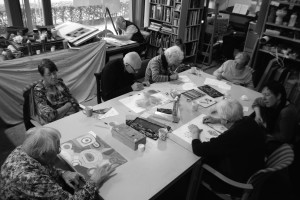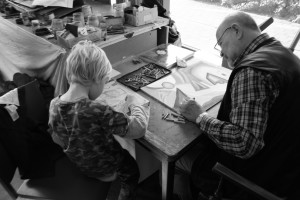Care art
Hein Walter (1962, Leiden) is a visual artist and poet. He is artistic leader of the foundation De Zijderups (for the development and execution of social art projects) and carries out various projects with it every year. He is also artistic leader of the Artists Association Flevoland. Since 2011 he has his studio in Archipel, a care centre in Almere. In this capacity he calls himself care artist.

It's Monday morning, ten o'clock. I enter the code and go to the living rooms. Sjaan is ready as usual with her coat on her walker. We say good morning to each other. I also shake hands with the other residents. I always call the residents by their first names. I'd like to be addressed by my first name when I'm old, but it's not common in the healthcare sector. I do it because I want to work with them, be friends with them. Of course I'm their carer, but I don't want to be above them.
Sjaan lives in Archipelhof: the closed section of Archipel residential and care centre. The living rooms have their own front doors. The front doors open onto a closed, central garden. You cannot enter or leave without a code. I have my studio in Archipel. I work with residents, but I also make my own work there. I am not employed by Archipel. I have an exchange agreement: I have my studio in exchange for work. I get my income from subsidies for projects with elderly people. For a while I received a monthly allowance and I thought that was right, because my work and creativity is worth much more than just the rent for my studio, but Archipel had to make serious cutbacks. I'm sure there will be better times ahead.
I'm taking Sjaan to my studio. Past the door with the code. The last bit has to be done without a walker - I hold her hands and slowly walk backwards. When she is seated, I pull her chair over. I've already laid out the drawing she's working on, but I know she won't start until I'm back. I go back to the living rooms and fetch Lies, Frank and Annie one by one. There are over forty elderly people living here with dementia, of which about ten come to my studio regularly at the moment.
They work with soft pastel chalk on paper. Good materials! A box of twelve sticks costs over twenty euros. I also work with them myself. I usually let them work abstractly. They start with lines, spots and slowly they build up their work. When you see them draw like this and hear them talk, you wouldn't suspect that these people are demented. I give instructions and steer, in an unadorned way. Talent development with demented elderly people, that's what I call my work. In a natural way they find their own style and they get better and better.
At the same time, I am a kind of social studies teacher during these meetings. I don't ask the residents about their personal experiences, not about their lives, but I ask them about their view of nature, for example, or I ask a question about the prison system, strict punishment or not, or what a Dutchman is. Open questions and varied. Or I give them a dilemma about a possible future, which will become real if a device is invented that prevents aging and people from dying. At what age would you use that device? Would you want to be 20 forever? Forever 30? What does a person actually learn at a later age? I always find conversations like this inspiring and fascinating. The elderly people with dementia are very good at talking and they don't feel like they're failing at times like that. If I ask them about their own personal lives, there's a good chance they'll feel they've failed, because it's likely they've forgotten things. Often people from outside come too. A mixed company, that is good for everyone. I always have music on. Classical. Usually in the background, but sometimes I can turn the music up loud. Then no conversation. And before we know it, it's twelve o'clock and I'm bringing the residents back. Time to eat.
Projects
In the afternoon I have an appointment with three pupils of primary school De Omnibus. Together we visit a resident of the sheltered housing. Then I have a conversation about his life.
The children attend and make a visual report. We have an hour and a half. Then I bring the children back to school. I write biographical fairy tales based on life stories. One of the projects I am doing at the moment. Twenty-eight residents participate and four groups of seven of The Omnibus. The children make illustrations. We will conclude the project with a book and an exhibition. The working title of the project is Young fairy tales by old people (with subsidy from funds for the elderly). Part of the project is that the elderly read their own fairy tale in class. I have organized that a few times now. Wonderfully beautiful situations are the result. I remember how Gé read out her fairy tale: the crackling voice of a ninety year old lady and thirty quiet children. Halfway through Gé became emotional - the fairy tale is largely biographical and she read a moving passage - and many children also got tears in their eyes.
A care artist in every care home! That is my vision. A creative oasis in every care home and an artist who provides new ideas and fresh projects. Would it be possible? It certainly could! My position as care artist in Archipel in Almere proves that it works out well for all parties - for the residents, for the environment, for Archipel and also for myself.
Future
The road is still long, but I see a future in which care institutions and artists will increasingly discover each other. Artists will get paid work in the care sector and care institutions will become creative organisations. Doctors, nurses, spiritual counsellors, activity counsellors, physiotherapists will then work together with care artists, movement artists, philosophers, you name it, to ensure the well-being of old people. Those who develop creatively, physically and mentally will be less dependent on care.
How does the Care Artistship work?
In the care centre a space has been made available as a studio. The care artist is free to use this studio. Day and night. In that studio, the artist works with residents, but he/she also creates his/her own work there.
- The artist is as a ZZP'er connected to the care institution. For care art a fixed fee has been set (on account) of €1.000,- per month. (incl. VAT and materials). This fee is fixed, so it is not negotiable.
The conditions for the Artist
- In return, the artist works with residents and puts his or her skills at the service of the care centre.
- The artist works with residents on a weekly basis, but he/she also carries out projects. Art projects with residents and people from the neighbourhood. (Large and small projects, painting projects, literary, musical projects - very diverse)
- There is an exhibition space that is open to the public. The care artist manages this exhibition space and creates exhibitions there - including the results of the projects.
- The care artist writes grant applications to generate money for the projects. This fundraising is also used to increase the income (€1.000,- a month is a good base, but not enough to live on).
- The artist masters different disciplines: at least photography/design and photo editing (Photoshop and InDesign). He/she must also be able to write well (press releases, etc.) and experience with fundraising is desirable. The main discipline can be various: graphics, painting, drawing, photography, sculpture, or, for example, spatial.
- He/She should make social contacts easily, be sociable, and a good network is preferred.
- The artist remains self-employed and thus autonomous.
- The artist is free to schedule the work himself and is free to approach residents, but he/she must be working for the benefit of the institution for at least about ten hours a week (but this may of course be more).
- The artists themselves must also work in the studio, making autonomous work there. Care art and their own careers as artists run parallel and reinforce each other.
- The care artist is not an activity leader! The care artist reports (briefly) weekly to the manager.
- The care artist does not have a contract, but each year it is decided whether the institution will continue with him/her.
POSITIVE ASPECTS OF CARE ART
- Within the care institution there is attention for creative meaning, well-being and talent development and the residents benefit from this.
- The care artist is an addition to the activity counselling and he/she takes work/attention out of the hands of the nursing staff.
- The care artist provides supplementary care for residents with dementia and in doing so, the care institution is responding to a growing demand in society.
- The care artist is a striking figure within the institution and creates a stir. The studio of the care artist is a creative oasis within the institution.
- The care artist is the house photographer. He/she can make good photographic portraits of residents and staff; he/she makes these photos available to the family of the residents free of charge. He/she photographs the residents when they enter, but also regularly afterwards, so that each resident has his/her own photographic archive. He/she can also provide visual reports of events.
- The care artist may be called upon to design things, such as a design for a card, an invitation or a poster.
- The care artist is a link between inside and outside. Because of the art projects, people from outside come inside, because they cooperate or because they come to watch. Especially in projects with children and schools! Also people from her/his network come to look at her/his work. People who otherwise would not have any contact with the care institution, now come in and get a taste of the atmosphere.
- The care artist is a public figure and because of him and the art projects, the care institution regularly receives good publicity.
- The care artist is not a traditional care provider and that is refreshing. His/her expectations and challenges are different. He/She will, for example, deal differently with residents suffering from dementia and this could be the answer to a major social problem. Talent development in dementia sufferers, for example, is one of the developments made visible by Care Art. If there is no hurry, but concentration and challenges are present, then the elderly can develop creatively and cognitively.
WHAT QUALITIES DOES THE CARE ARTIST HAVE
- The care artist masters various creative skills, at least photography and writing. The basis is his/her creative profession, which can be painting, spatial, graphic or other. The care artist is social, has good contact skills, and is able to cooperate well. During the creative work, there is a lot of talking. The care artist is not only a facilitator, but also a discussion leader. In principle everything can be talked about. A kind of social or philosophical lesson. But in an atmosphere that everyone is taken seriously.



